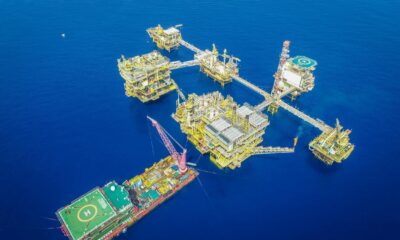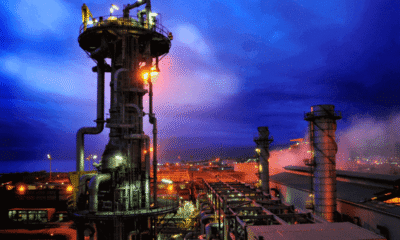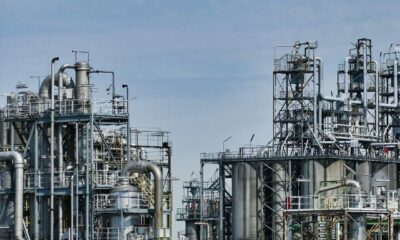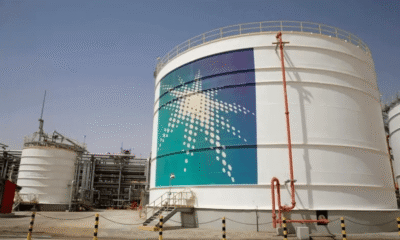Brent crude oil price, on May 19, closed at roughly $65.54 per barrel compared with $65.41 recorded on May 16. At the same time, WTI crude oil price closed at approximately $62.14 per barrel compared with $62.08 recorded on May 18.
According to the Organization of the Petroleum Exporting Countries (OPEC), the basket price of thirteen crude oil blends stood at $64.65 per barrel on May 19, compared to $64.08 a barrel recorded on May 16.
The OPEC Reference Basket of Crudes (ORB) consists of the following: Saharan Blend (Algeria), Djeno (Congo), Zafiro (Equatorial Guinea), Rabi Light (Gabon), Iran Heavy (Iran), Basrah Medium (Iraq), Kuwait Export (Kuwait), Es Sider (Libya), Bonny Light (Nigeria), Arab Light (Saudi Arabia), Murban (UAE) and Merey (Venezuela).
Specific crude oil prices for Nigeria’s Bonny Light, Brass River, and Qua Iboe for May 19 include:
|
Nigeria Crude Blend
|
Prices ($ Per Barrel)
|
|
Qua Iboe
|
66.97
|
|
Brass River
|
66.92
|
|
Bonny Light
|
65.57 (As of May 16 2025)
|
Read: Crude Oil Prices May 15, 2025: Brent & WTI Rates
Factors Influencing Crude Oil Prices: May 19, 2025
- Moody’s downgrade of US sovereign credit rating
- Official data that showed slowing growth in China’s April industrial output and retail sales.
- Both developments raised concerns over the outlook for the world’s two biggest economies and expectations that oil demand could slow, after Beijing and Washington’s agreement to roll back most tariffs on each other’s goods pushed oil prices higher.
Brent vs WTI Crude Oil Prices
Brent is the global standard pricing for around 60% of the world’s crude from Africa, Europe, and the Middle East. It is traded on the ICE Futures Exchange. Conversely, WTI is the benchmark pricing for crude from the United States. It is more influenced by domestic inventory levels and pipeline constraints ( Cushing, Oklahoma storage hub). It is also traded on the New York Mercantile Exchange (NYMEX).
Key Differences Between Brent and WTI Crude
- Geography: Brent is sourced from the North Sea, while WTI comes from the United States, primarily Texas.
- Sulfur Content: Brent and WTI contain light and sweet oil. However, WTI typically has lower sulfur content than Brent.
- Pricing: Brent crude is generally priced higher than WTI due to logistical and geopolitical factors. The price difference constantly fluctuates based on demand and supply, transportation costs, geopolitics, and other factors.
Why do Brent and WTI have Different Prices?
- Geographical & Transportation Costs: Brent crude is explored from the North Sea (Europe) and shipped via seaborne oil tankers. However, WTI crude is explored and produced in the United States (Louisiana, Texas, and North Dakota) and transported primarily via pipelines, cheaper than shipping by sea. Since Brent depends on expensive shipping tankers, its price factors in higher transportation premiums
- Political & Economic Risks: Brent Crude is more vulnerable to global disruptions like OPEC cuts, European demand shifts, and Middle East conflicts. However, WTI is more insulated by US production and infrastructure. For example, the Russia-Ukraine war pushed Brent prices higher than WTI due to fears of European supply.
Can WTI Price Surpass Brent Crude Price?
This is rare but can occur due to US export surges or the tightening of global supplies. The US government’s removal of oil export restrictions in 2015 has narrowed the Brent-WTI price gap. Still, Brent remains the default for international buyers due to established trading hubs and liquidity.
| Factor | Brent Crude | WTI Crude |
| Origin | North Sea (Europe) | Texas, United States |
| Sulfur Content | Low (0.37%) | Very Low (0.34%) |
| Density (API) | ~38° (Light Sweet Crude) | ~39.6° (Lighter than Brent) |
| Pricing Influence | Global benchmark (Europe, Asia, Africa) | U.S. benchmark |
| Futures Exchange | ICE (Intercontinental Exchange) | NYMEX (New York) |
| Transportation Costs | Higher (offshore drilling) | Lower (U.S. pipeline network) |
Brent Vs Nigeria Crude Oil Prices
Nigeria produces multiple crude oil grades, including Bonny Light, Brass River, Forcados, Qua Iboe, etc. Since Nigeria exports mainly light sweet crude (similar to Brent), its prices are set relative to the Brent benchmark. However, Nigeria’s crude is not priced at Brent’s exact rate but as a differential (either a premium or discount). The Nigerian National Petroleum Limited (NNPC), the state-owned oil company, sets the Official Selling Price (OSP) for crude oil. It is the price at which Nigeria sells its crude oil to international buyers. The OSP is generally determined based on:
- Brent price benchmarks
- Global oil market trends (Demand-Supply Balance),
- Quality of Nigerian crude grades ( Brass River, Bonny Light, Forcados, or Qua Iboe).
Crude Grade | Typical Price Difference vs. Brent | Key Reasons for Difference | Key Buyers |
Brent Crude | Baseline Pricing Reference | Global pricing reference (Light Sweet) | Asia, Europe, Global |
Qua Iboe (Nigeria) | +$0.30 to +$3.50 per barrel | High-quality light sweet crude, similar to Bonny Light. One of Nigeria’s best grades | US & Europe |
Bonny Light (Nigeria) | +$0.50 to +$3.00 per barrel | High-quality, light sweet crude; often trades above Brent. Preferred by European refiners | Asia, the US, & Europe |
Forcados (Nigeria) | +$0.50 to +$2.00 per barrel | Heavier than Bonny Light but still sweet | Asia & Europe |
Brass River (Nigeria) | +$0.40 to +$2.50 per barrel | Similar to Bonny Light. Slightly less favored than Bonny Light due to occasional quality issues | Asia & Europe |
Why Brent is the Pricing Benchmark for Nigeria
- Similar Oil Characteristics: Both Brent and Nigerian crudes (Bonny Light, Qua Iboe) are light & sweet (low sulfur), making them outstanding for gasoline refining.
- Global Standard: Brent is the most widely used benchmark for Atlantic Basin crude oil, which includes Nigerian exports. Thus, Nigeria aligns with it for pricing transparency.
- European Market Reliance: Nigeria exports most of its crude oil to Europe, where Brent dominates pricing.
- Pricing Transparency: Most international buyers reference Brent. Therefore, Nigeria aligns its crude prices with Brent’s to remain competitive.
Nigeria’s Challenge: Why It Doesn’t Set Its Own Oil Benchmark
Despite being Africa’s largest oil producer, Nigeria does not control its own crude oil pricing benchmark—unlike the US (WTI), UAE (Murban), Saudi Arabia (Arab Light) and Russia (Urals). Instead, it depends on Brent Crude as its reference price. Here’s why:
- Absence of a Futures Market: Brent and WTI have functional futures markets (ICE & NYMEX), enabling fair market and pricing. Therefore, with no similar exchange in Nigeria, the country relies on Brent. Without futures contracts, Nigerian crude prices are set reactively (based on Brent + adjustments) instead of independently.
- Supply Disruptions:
- Oil theft & pipeline vandalism (~200,000 to 400,000 bpd lost in 2023).
- Force majeure declarations: Bonny Light and Forcados shutdowns due to vandalism or technical issues at Trans Niger Pipeline and Trans Forcados Pipeline, respectively. A benchmark requires a stable, predictable supply. Unfortunately, Nigeria struggles with this situation. Frequent disruptions harm pricing power.
- Lower Production & Export Volume vs. Major Producers
Country | Crude Benchmark | 2024 Avg Exports (Million Barrels Per Day) |
Saudi Arabia | Arab Light | 5.95 |
The United States | WTI (NYMEX) | 4.1 |
Nigeria | Priced vs. Brent | 1.3 - 1.5 |
- Saudi Arabia: Leading OPEC exporter, with exports fluctuating based on OPEC+ quotas.
- Nigeria: Struggled with production issues (theft, underinvestment) but aimed for ~1.5 million bpd in 2024.
- United States: Exports surged due to shale production, averaging ~4.1 million bpd (EIA estimates).
Country | Crude Benchmark | 2024 Avg Production (Million Barrels Per Day) |
The United States | WTI | 13.2 |
Saudi Arabia | Arab Light | 12.7 |
Nigeria | Priced vs. Brent | 1.69 |
- The United States: The US crude oil production in 2024 averaged 13.2 million barrels per day. The massive growth of shale production is the key reason for the record-high production.
- Saudi Arabia: Saudi Arabia’s oil production in 2024 averaged 12.7 million barrels per day. Thus, it is the world’s second-largest oil producer.
- Nigeria: Nigeria’s crude oil production averaged 1.56 million barrels daily in 2024, reflecting ongoing challenges in meeting production targets.
Therefore, Nigeria’s production and crude export output are too small to dictate global prices.
Key Factors Affecting Nigeria’s Brent Crude Price Differential
Nigeria’s crude blends are generally traded at a discount or premium to Brent crude price, depending on:
- Global demand for light sweet crude.
- Supply disruptions in Nigeria ( pipeline vandalism, oil theft, militant attacks, force majeure).
- Freight costs to key markets (Asia, US, and Europe).
Factors | Impact on Nigeria’s Crude Price |
Strong Demand (Europe/US/Asia): Summer driving season & strong economic growth Weak Demand: Refinery maintenance in Europe/Asia & global recession fears. | Strong Demand → Higher premium Weaker Demand → Discounts |
Supply Disruptions: (Pipeline Attacks, Theft, Forcados) | Discount |
Alternative supplies: (US shale oil or Russian Urals competing in Europe) | Excess US supplies → Discounts |
OPEC+ Policy & Quota Compliance Excess Supply: If OPEC+ increases production, Nigerian crude may sell cheaper. Production cuts: If OPEC+ cuts production, Nigerian crude may sell at premium if demand is strong. | Excess supply → Discounts Lower cuts → Higher premium |
Geopolitical Tensions Geopolitical tensions, such as the Russia-Ukraine War and Yemen Houthi attacks on commercial ships along the Red Sea tend to disrupt supply chains, leading to higher prices. | Geopolitical Tensions → Supply disruptions → Higher premium |
US Dollar Strength & Federal Reserve Policy (Oil is priced in US Dollar) Higher US interest rates: Leads to stronger dollar which oil more expensive for importers. Fed rate cuts: Weaken the US Dollar boosting oil demand. | Higher rates → Stronger US Dollar → Higher crude prices → Lower demand → Discount Lower rates → Weaker US Dollar → lower crude prices → higher demand → Premium |
Where to Buy Nigeria Crude Oil
Along with Egypt, Algeria, and Libya, Nigeria is among Africa’s largest crude oil producers. The country generally produces light, sweet crude oil (Forcados, Qua Iboe, Escravos Light, and Bonny Light), which is highly demanded by global markets. To purchase Nigerian crude oil, there are several ways to do so:
- Direct Purchase from the Nigerian National Petroleum Company Limited (NNPC Limited): The NNPC is the state-owned oil company responsible for Nigeria’s oil & gas resources through a joint venture or Production Sharing Contract with oil producers. NNPC Limited sells its equity crude oil through term contracts and spot sales. However, Buyers must meet strict operational and financial requirements. Some of these conditions include proof of funds and a stable track record in oil trading.
- International Oil Trading Companies: Many global international oil companies and commodity traders buy and resell Nigerian crude.
- Commodity Traders: Vitol, Trafigura, Glencore, Gunvor, and Mercuria,
- International Oil Companies: Shell, Chevron, TotalEnergies, etc.
- Nigerian Oil & Gas Trading Companies: Some Nigerian-based oil companies, including Oando PLC and Aiteo Group, trade crude oil as intermediaries.
- Government-to-Government (G2G) Deals: Some countries, like India, purchase Nigerian crude directly through government-backed deals.




























Pingback: Crude Oil Prices May 20, 2025: Brent & WTI Rates - Nigeria Oil Digest